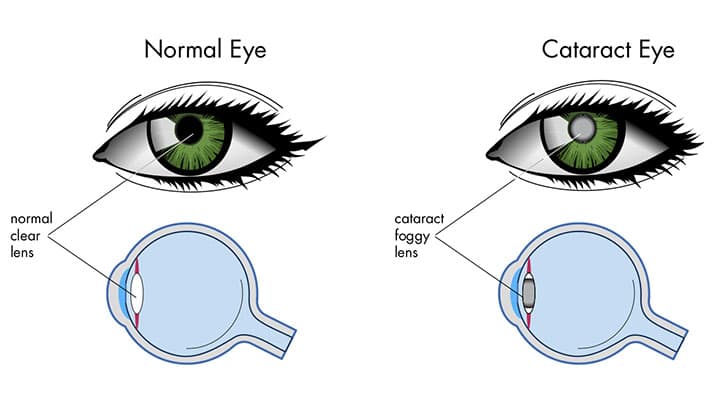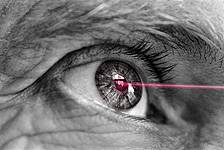With more than 20 million cases worldwide, cataracts are the most common cause of vision loss in adults over 45.
What are cataracts?
A cataract is the clouding of the eye’s focusing lens that results in blurry vision, and eventually leads to vision loss, if left untreated.
- Cataracts affect more than 50% of all adults above the age of 80.
- By age 60, more than half of all adults will begin to develop a cataract.
Cataracts develop gradually over time, without causing any pain or significant discomfort, so it could take decades before you notice any signs of the condition.
How do cataracts develop?
The lens of the eye is mostly made up of water and protein, naturally arranged to maintain transparency and enable light to pass through to the retina at the back of the eye.
The lens is also responsible for adjusting the eye’s focus, to enable clear vision at all distances, such as when driving a car. The lens changes focus so you can clearly see the road or street sign ahead, then look down at your speedometer, and back to the road.
However, as we age, the proteins in the lens begin to lose their transparency and collect together, causing a “clouding” of part of the lens, called a cataract.
Over time, the cataract may worsen and affect more of the lens, making it more difficult to see clearly.
Types of cataracts
The majority of cataracts develop due to the natural aging process. However, other types of cataracts can develop as well, including
- Congenital cataracts are present at birth.
- Secondary cataracts can result from eye surgery or other ocular diseases, such as glaucoma or diabetes.
- Traumatic cataracts can develop from an eye injury.
Where are cataracts located in the eye?
Cataracts are medically termed according to their location in the lens:
- A nuclear cataract is located in the center of the lens, and causes the nucleus to darken— changing from clear to yellow or brown.
- A cortical cataract is located in the layer surrounding the nucleus, and appears similar to a wedge or a spoke.
- A posterior capsular cataract is located in the back outer layer of the lens, and develops more rapidly than other cataracts.
Do I have a cataract?
Cataract symptoms may differ from person to person, depending on the individual, and the type of cataract. Some people experience a phenomenon known as “second sight”, in which near vision improves for a short time, typically until the cataract worsens.
An easy way to understand the visual effects of a cataract is by imagining what it feels like to look through a dirty window.
Common signs and symptoms of cataracts:
- Blurry or cloudy vision
- Glare sensitivity from sunlight or headlights
- Seeing halos around lights
- Poor night vision
- Colors appearing less vibrant
- Double vision
How is a cataract diagnosed?
Cataracts can only be diagnosed through a comprehensive eye examination.
Your eye doctor will utilize diagnostic tools to measure the following:
Visual acuity to determine to the extent at which a cataract may be limiting clear vision at all distances.
Refraction will determine if your vision has changed, requiring a new optical prescription for eyeglasses or contact lenses.
Evaluation of the lens using high magnification and illumination to identify the location and extent of any cataracts.
Evaluation of the retina of the eye through pupil dilation.
Measurement of pressure within the eye.
Additional testing for color vision and glare sensitivity may be conducted as well.
Further testing may be required to determine the cataract’s impact on vision, and to assess candidacy for cataract surgery.
If you have symptoms of cataracts, contact an eye doctor near you, who can diagnose and discuss the best treatment options.
SEE RELATED: Cataract Surgery: What to Expect
Cataract treatment
The early symptoms of cataracts can be treated by wearing anti-glare sunglasses, glasses with magnification lenses, or a stronger optical prescription.
Surgery will be recommended when the cataracts begin to seriously impair your vision— affecting daily activities, such as reading, crafts, driving or watching TV.
What is cataract surgery?
Cataract surgery has proven to be very successful in restoring vision, and reducing or even eliminating the need to wear glasses, many even achieve 20/20 distance vision after their cataract surgery.
Cataract surgery is a common, and relatively painless procedure that involves replacing your clouded eye lens with a clear, plastic intraocular lens (IOL) that contains an optical power to correct any refractive errors and improve vision clarity.
- Cataract surgery is one of the safest and most effective types of surgery.
- Over 90% of patients report improved vision following cataract surgery.
There are two primary approaches to cataract surgery:
Small-incision cataract surgery involves a process called phacoemulsification. During this surgery, a tiny probe is inserted into the side of the cornea (the clear outer covering of the eye), through a small incision. The probe emits ultrasound waves that soften and break up the lens to enable easy suctioning from the eye.
Extracapsular surgery involves a larger incision in the cornea to enable removal of the lens core in one piece.
What should I expect with cataract surgery?
Here’s a brief guide to cataract surgery.
Cataract surgery is usually performed in a hospital or outpatient clinic. The procedure generally takes around 30-45 minutes. You may experience some soreness or discomfort after the procedure— this is common and should subside within a couple of days.
Improved vision is typically noticed immediately, with continued improvement over the following weeks. It’s important to adhere to all post-surgery care instructions to enable optimal results, and follow-up with your eye doctor as directed.
Eyewear after cataract surgery
During cataract surgery, the natural lens is replaced by an intraocular lens (IOL). The optical power of the IOL is calculated to enable clear vision without the need for eyewear.
However, in some cases, an IOL implant may not be able to fully correct the optical prescription. In this case, reading glasses or progressive lenses may be necessary to correct mild residual refractive errors or presbyopia.
Glasses with anti-reflective coating and photochromic lenses are usually recommended to enhance vision and comfort after cataract surgery.
Can I prevent cataracts from developing?
Eventually, all people develop cataracts.
While most cataracts develop as a result of aging, research has shown that there are health, environmental, and behavioral factors that can increase your risk for developing a cataract.
Many of these risk factors include:
- Smoking
- Excessive alcohol consumption
- Prolonged exposure to ultraviolet (UV) radiation
- Obesity
- Diabetes
- Hypertension
- Prolonged use of steroids or statin medications
- Eye injury or eye surgery
- Nutritional deficiency
You may be able to lower the effects of many of these risk factors by making some lifestyle changes:
- Wear protective sunglasses to avoid UV radiation
- Consume a healthy diet rich in vitamins C and E, lutein, zeaxanthin, zinc and Omega 3
- Avoid smoking and excessive alcohol consumption
- Schedule regular eye exams to detect early signs of cataracts.
LEARN MORE: Guide to Eye Conditions
If you or a loved one is experiencing symptoms of a cataract, schedule a comprehensive eye exam for a full diagnosis.
Early detection and treatment of cataracts will enable you to enjoy a lifetime of clear vision.









